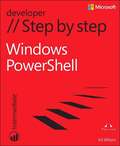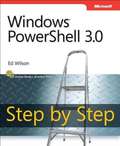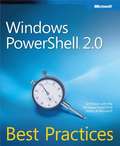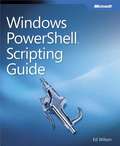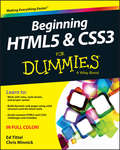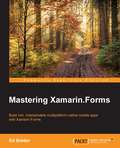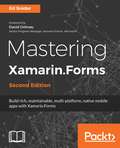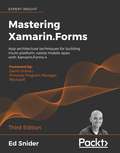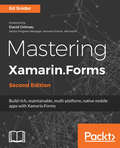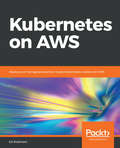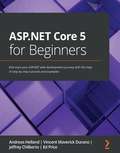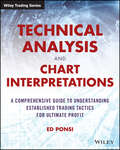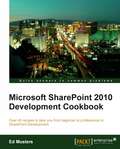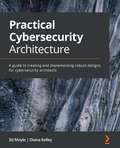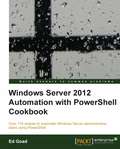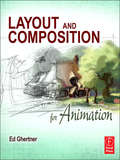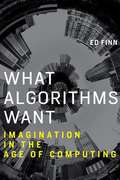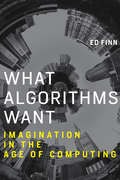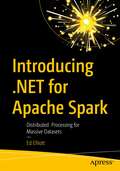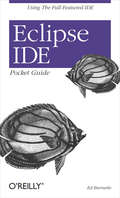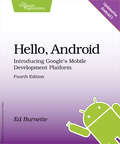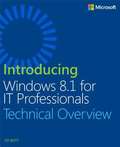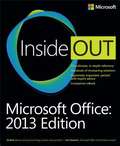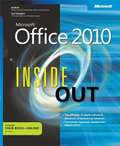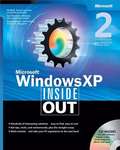- Table View
- List View
Windows PowerShell Step by Step, Third Edition
by Ed WilsonYour hands-on guide to Windows PowerShell scripting fundamentals <P><P>Expand your expertise--and teach yourself the fundamentals of Windows PowerShell scripting, including features available in Windows PowerShell 5. If you are an IT professional, power user, or consultant, you’ll get the guidance, exercises, and code you need to master core techniques for automating Windows setup, deployment, and management. <P><P>Discover how to: <ul> <li>Run cmdlets and command-line utilities</li> <li>Administer Windows-based servers and desktops with built-in cmdlets</li> <li>Use providers to access external information</li> <li>Write and run scripts from the Windows ISE</li> <li>Create functions that are easy to maintain</li> <li>Build standardized environments with profiles</li> <li>Automate Windows systems with WMI, CIM cmdlets, and remoting</li> <li>Automate Active Directory Domain Services (AD DS)</li> <li>Debug scripts and handle errors</li> <li>Run commands that survive interruptions</li> <li>Use Desired State Configuration (DSC) to manage software services and their environments</li> <li>Get powerful new modules from PowerShell Gallery</li> </ul> <P><P>About You <br></br> This book is for: <ul> <li>IT professionals and power users who want to get productive with Windows PowerShell, including new features in Windows PowerShell 5</li> <li>Windows system administrators who want to be more efficient and productive</li> <li>Anyone pursuing Windows PowerShell certifications </li> </ul> <P><P>No experience with Windows PowerShell or other scripting technologies necessary
Windows PowerShellTM 3.0 Step by Step
by Ed Wilson<p>Teach yourself the fundamentals of Windows PowerShell 3.0 command line interface and scripting language—one step at a time. Written by a leading scripting expert, this practical tutorial delivers learn-by-doing exercises, timesaving tips, and hands-on sample scripts for performing administrative tasks on both local and remote Windows systems.</p>
Windows PowerShell™ 2.0 Best Practices
by Ed WilsonApply best practices for automating system administration with Windows PowerShell 2.0 and optimize your operational efficiency and results. This guide captures the field-tested tips, real-world lessons, and candid advice of practitioners across the range of business and technical scenarios and across the scripting life cycle. Discover how to: Take advantage of new features and cmdlets in Windows PowerShell 2.0 Plan scripting usage scenarios and define standards Deploy Windows PowerShell 2.0 to desktops and servers Configure scripting environments Optimize remote scripting capabilities Work with Active Directory(r) and WMI Design functions and modules Optimize input and output Handle errors Document scripts Test and troubleshoot scripts Avoid scripting pitfalls The companion CD includes a fully searchable eBook and sample scripts. A Note Regarding the CD or DVD: The print version of this book ships with a CD or DVD. For those customers purchasing one of the digital formats in which this book is available, we are pleased to offer the CD/DVD content as a free download via O'Reilly Media's Digital Distribution services. To download this content, please visit O'Reilly's web site, search for the title of this book to find its catalog page, and click on the link below the cover image (Examples, Companion Content, or Practice Files). Note that while we provide as much of the media content as we are able via free download, we are sometimes limited by licensing restrictions. Please direct any questions or concerns to booktech@oreilly.com.
Windows PowerShell™ Scripting Guide
by Ed WilsonGet practical guidance for using Windows PowerShell to manage Windows Vista and Windows Server 2008. Written by Ed Wilson, a leading scripting expert and trainer at Microsoft, this reference offers a task-based approach to help you find the information you need for day-to-day tasks. With more than 200 scripts, it offers rich examples that administrators can customize for their own environment and needs. The scripts range in complexity from one-line commands, to full-blown scripts with managed output and command-line arguments--examples that are applicable to all skill levels. Includes a companion CD with fully searchable eBook, sample scripts, and other resources for managing your Windows-based environment. A Note Regarding the CD or DVD The print version of this book ships with a CD or DVD. For those customers purchasing one of the digital formats in which this book is available, we are pleased to offer the CD/DVD content as a free download via O'Reilly Media's Digital Distribution services. To download this content, please visit O'Reilly's web site, search for the title of this book to find its catalog page, and click on the link below the cover image (Examples, Companion Content, or Practice Files). Note that while we provide as much of the media content as we are able via free download, we are sometimes limited by licensing restrictions. Please direct any questions or concerns to booktech@oreilly.com.
Beginning HTML5 and CSS3 For Dummies
by Ed Tittel Chris MinnickYour full-color, friendly guide to getting started with HTML5 and CSS3!HTML and CSS are essential tools for creating dynamic websites and help make your websites even more effective and unique. This friendly-but-straightforward guide gets you started with the basics of the latest versions of HTML and CSS: HTML5 and CSS3. Introducing you to the syntax and structure of the languages, this helpful guide shows you how to create and view a web page, explains ideal usage of HTML5 and CSS3, walks you through the CSS3 rules and style sheets, addresses common mistakes and explains how to fix them, and explores interesting HTML5 tools.Serves as an ideal introduction to HTML5 and CSS3 for beginners with little to no web development experienceDetails the capabilities of HTML5 and CSS3 and how to use both to create responsive, practical, and well-designed websitesHelps you understand how HTML5 and CSS3 are the foundation upon which hundreds of millions of web pages are builtFeatures full-color illustrations to enhance your learning processBeginning HTML5 and CSS3 For Dummies is the perfect first step for getting started with the fundamentals of web development and design.
Mastering Xamarin.Forms
by Ed SniderBuild rich, maintainable multiplatform native mobile apps with Xamarin.Forms About This Book * Build an effective mobile app architecture with the Xamarin.Forms toolkit * Maximize the testability, flexibility, and overall quality of your Xamarin.Forms mobile app * This step-by-step tutorial is packed with real-world scenarios and solutions to build professional grade mobile apps with Xamarin.Forms Who This Book Is For This book is intended for C# developers who are familiar with the Xamarin platform and the Xamarin.Forms toolkit. If you have already started working with Xamarin.Forms and want to take your app to the next level and make it more maintainable, testable, and flexible, then this book is for you. What You Will Learn * Find out how, when, and why you should use architecture patterns and get best practices with Xamarin.Forms * Implement the Model-View-ViewModel (MVVM) pattern and data-binding in Xamarin.Forms mobile apps * Extend the Xamarin.Forms navigation API with a custom ViewModel-centric navigation service * Leverage the inversion of control and dependency injection patterns in Xamarin.Forms mobile apps * Work with online and offline data in Xamarin.Forms mobile apps * Test both business logic and user interface code in Xamarin.Forms mobile apps * Use platform-specific APIs to build rich custom user interfaces in Xamarin.Forms mobile apps * Explore how to improve mobile app quality with analytics and crash reporting using Xamarin Insights In Detail Discover how to extend and build upon the components of the Xamarin.Forms toolkit to develop an effective, robust mobile app architecture. Starting with an app built with the basics of the Xamarin.Forms toolkit, we'll go step by step through several advanced topics to create a solution architecture rich with the benefits of good design patterns and best practices. We'll start by introducing a core separation between the app's user interface and the app's business logic by applying the MVVM pattern and data binding. Discover how to extend and build upon the components of the Xamarin.Forms toolkit to develop an effective, robust mobile app architecture. Starting with an app built with the basics of the Xamarin.Forms toolkit, we'll go step by step through several advanced topics to create a solution architecture rich with the benefits of good design patterns and best practices. We'll start by introducing a core separation between the app's user interface and the app's business logic by applying the MVVM pattern and data binding. Then we will focus on building out a layer of plugin-like services that handle platform-specific utilities such as navigation, geo-location, and the camera, as well as how to use these services with inversion of control and dependency injection. Next we'll connect the app to a live web-based API and set up offline synchronization. Then, we'll dive into testing the app--both the app logic through unit tests and the user interface using Xamarin's UITest framework. Finally, we'll integrate Xamarin Insights for monitoring usage and bugs to gain a proactive edge on app quality. Style and approach This easy-to-follow, code-rich guide will walk you through building a real-world Xamarin.Forms mobile app from start to finish. Each chapter builds upon the app by applying new advanced functionalities, design patterns, and best practices.
Mastering Xamarin.Forms.: Build Rich, Maintainable, Multi-platform, Native Mobile Apps With Xamarin. Forms
by Ed SniderDiscover how to extend and build upon the components of the Xamarin.Forms toolkit to develop an effective, robust mobile app architecture. Starting with an app built with the basics of the Xamarin.Forms toolkit, you'll go step by step through several advanced topics to create a solution architecture rich with the benefits of good design patterns and best practices.
Mastering Xamarin.Forms: App architecture techniques for building multi-platform, native mobile apps with Xamarin.Forms 4, 3rd Edition
by Ed Snider David OrtinauNew edition of the bestselling guide to building an effective mobile app architecture with Xamarin.Forms 4 that maximizes the overall quality of apps. Key Features Updated for Xamarin.Forms 4 Packed with real-world scenarios and solutions to help you build professional grade mobile apps with Xamarin.Forms Includes design patterns and best practice techniques that every mobile developer should know Book Description Discover how to extend and build upon the components of the most recent version of Xamarin.Forms to develop an effective, robust mobile app architecture. This new edition features Xamarin.Forms 4 updates, including CollectionView and RefreshView, new coverage of client-side validation, and updates on how to implement user authentication. Mastering Xamarin.Forms, Third Edition is one of the few Xamarin books structured around the development of a simple app from start to finish, beginning with a basic Xamarin.Forms app and going step by step through several advanced topics to create a solution architecture rich with the benefits of good design patterns and best practices. This book introduces a core separation between the app's user interface and the app's business logic by applying the MVVM pattern and data binding, and then focuses on building a layer of plugin-like services that handle platform-specific utilities such as navigation and geo-location, as well as how to loosely use these services in the app with inversion of control and dependency injection. You'll connect the app to a live web-based API and set up offline synchronization before testing the app logic through unit testing. Finally, you will learn how to add monitoring to your Xamarin.Forms projects to track crashes and analytics and gain a proactive edge on quality. What you will learn Find out how, when, and why to use architecture patterns and best practices with Xamarin.Forms Implement the Model-View-ViewModel (MVVM) pattern and data binding in Xamarin.Forms mobile apps Incorporate client-side validation in Xamarin.Forms mobile apps Extend the Xamarin.Forms navigation API with a custom ViewModel-centric navigation service Leverage the inversion of control and dependency injection patterns in Xamarin.Forms mobile apps Work with online and offline data in Xamarin.Forms mobile apps Use platform-specific APIs to build rich custom user interfaces in Xamarin.Forms mobile apps Explore how to monitor mobile app quality using Visual Studio App Center Who this book is for This book is intended for .NET developers who are familiar with Xamarin mobile application development and the open source Xamarin.Forms toolkit. If you have already started working with Xamarin.Forms and want to take your app to the next level, making it more maintainable, testable and flexible, then this book is for you.
Mastering Xamarin.Forms: Build rich, maintainable, multi-platform, native mobile apps with Xamarin.Forms, 2nd Edition
by Ed SniderCreate high-quality multi-platform native apps with Xamarin.FormsKey Features Packed with real-world scenarios and solutions to help you build professional-grade mobile apps with Xamarin.Forms Build an effective mobile app architecture with the Xamarin.Forms toolkit Find out how, when, and why you should use architectural patterns and get best practices with Xamarin.FormsBook DescriptionDiscover how to extend and build upon the components of the Xamarin.Forms toolkit to develop an effective, robust mobile app architecture. Starting with an app built with the basics of the Xamarin.Forms toolkit, you'll go step by step through several advanced topics to create a solution architecture rich with the benefits of good design patterns and best practices. You'll start by introducing a core separation between the app's user interface and its business logic by applying the MVVM pattern and data-binding. Then you focus on building out a layer of plugin-like services that handle platform-specific utilities such as navigation and geo-location, and on how to loosely use these services in the app with inversion of control and dependency injection. Next you connect the app to a live web-based API and set up offline synchronization. Then, you delve into testing the app logic through unit tests. Finally, you set up Visual Studio App Center for monitoring usage and bugs to gain a proactive edge on app quality.What you will learn Implement the Model-View-View-Model (MVVM) pattern and data-binding in Xamarin.Forms mobile apps Extend the Xamarin.Forms navigation API with a custom ViewModel-centric navigation service Leverage the inversion of control and dependency injection patterns in Xamarin.Forms mobile apps Work with online and offline data in Xamarin.Forms mobile apps Test business logic in Xamarin.Forms mobile apps Use platform-specific APIs to build rich custom user interfaces in Xamarin.Forms mobile apps Explore how to improve mobile app quality using Visual Studio AppCenterWho this book is forThis book is intended for C# developers who are familiar with the Xamarin platform and the Xamarin.Forms toolkit. If you have already started working with Xamarin.Forms and want to take your app to the next level with higher quality, maintainability, testability, and flexibility, then this book is for you.
Kubernetes on AWS: Deploy and manage production-ready Kubernetes clusters on AWS
by Ed RobinsonLearn to implement container orchestration on AWS with easeKey FeaturesLeverage the power of Kubernetes on AWS to deploy highly scalable applicationsProvision Kubernetes clusters on Amazon EC2 environmentsImplement best practices to improve efficiency and security of Kubernetes on the cloudBook DescriptionDocker containers promise to radicalize the way developers and operations build, deploy, and manage applications running on the cloud. Kubernetes provides the orchestration tools you need to realize that promise in production.Kubernetes on AWS guides you in deploying a production-ready Kubernetes cluster on the AWS platform. You will then discover how to utilize the power of Kubernetes, which is one of the fastest growing platforms for production-based container orchestration, to manage and update your applications. Kubernetes is becoming the go-to choice for production-grade deployments of cloud-native applications. This book covers Kubernetes from first principles. You will start by learning about Kubernetes' powerful abstractions - Pods and Services - that make managing container deployments easy. This will be followed by a guided tour through setting up a production-ready Kubernetes cluster on AWS, while learning the techniques you need to successfully deploy and manage your own applications.By the end of the book, you will have gained plenty of hands-on experience with Kubernetes on Amazon Web Services. You will also have picked up some tips on deploying and managing applications, keeping your cluster and applications secure, and ensuring that your whole system is reliable and resilient to failure.What you will learnLearn how to provision a production-ready Kubernetes cluster on AWSDeploy your own applications to Kubernetes with HelmDiscover strategies for troubleshooting your cluster and know where to find help with issuesExplore the best ways to monitor your cluster and the applications running on itSupercharge your cluster by integrating it with the tools provided by the AWS platformArchitect your cluster for high availabilityWho this book is forIf you’re a cloud engineer, cloud solution provider, sysadmin, site reliability engineer, or developer with an interest in DevOps and are looking for an extensive guide to running Kubernetes in the AWS environment, this book is for you. Though any previous knowledge of Kubernetes is not expected, some experience with Linux and Docker containers would be a bonus.
ASP.NET Core 5 for Beginners: Kick-start your ASP.NET web development journey with the help of step-by-step tutorials and examples
by Ed PriceThis book is for developers who want to learn how to develop web-based applications using the ASP.NET Core framework. Familiarity with the C# language and a basic understanding of HTML and CSS is required to get the most out of this book.
Technical Analysis and Chart Interpretations: A Comprehensive Guide to Understanding Established Trading Tactics for Ultimate Profit (Wiley Trading)
by Ed PonsiEd Ponsi's straightforward guide to understanding technical analysis Technical Analysis and Chart Interpretations delivers simple explanations and easy-to-understand techniques that demystify the technical analysis process. In his usual straightforward style, bestselling author Ed Ponsi guides you through the twists and turns to show you what really matters when it comes to making money. Whether you trade stocks, currencies, or commodities, you'll develop invaluable skills as you master difficult concepts and the tools of the trade. Technical analysis translates to any form of trading, and this book delivers clear, jargon-free guidance toward interpreting the various charts you'll see in the field. Technical analysis can be confusing. Volatility, cycles, Elliot waves, Fibonacci, trends—it's easy to get lost, and most of the available literature is incomprehensible to all but the experts. This book is different—it's technical analysis for the rest of us. You'll see through the language to understand the underlying concepts, and how to apply them correctly. Learn what true technical analysis entails Discover the tools that simplify accurate analysis Master the tactics and strategies used by the pros Develop a valuable trading skill that transcends markets Simply recognizing the vocabulary isn't nearly enough, and a passing acquaintance with the topic is guaranteed to do more harm than good. When technical analysis methods are used incorrectly, they are ineffective at best, and actively destructive to your bottom line at worst. Technical Analysis and Chart Interpretations cuts through the confusion to give you a firm understanding and the skills to apply it correctly.
Microsoft SharePoint 2010 development cookbook
by Ed MustersThe plan of the book is to build a relationship with the Author as your personal guide through the most common "pattern" of SharePoint development. In cookbook style, you will be led carefully step by step through a comprehensive set of recipes. The practical example starts quickly and builds logically throughout the chapters to create a common theme. You will be developing coding techniques that you will be able to apply to the real world. In fact, this book will train you for the first SharePoint development project you will join. This book is written for the ASP.NET developer who wants to get to the goal of "professional" SharePoint 2010 developer as quickly as possible, by learning the most important practical aspects of development that will be used in the real world.
Practical Cybersecurity Architecture: A guide to creating and implementing robust designs for cybersecurity architects
by Ed Moyle Diana KelleyPlan and design robust security architectures to secure your organization's technology landscape and the applications you developKey FeaturesLeverage practical use cases to successfully architect complex security structuresLearn risk assessment methodologies for the cloud, networks, and connected devicesUnderstand cybersecurity architecture to implement effective solutions in medium-to-large enterprisesBook DescriptionCybersecurity architects work with others to develop a comprehensive understanding of the business' requirements. They work with stakeholders to plan designs that are implementable, goal-based, and in keeping with the governance strategy of the organization.With this book, you'll explore the fundamentals of cybersecurity architecture: addressing and mitigating risks, designing secure solutions, and communicating with others about security designs. The book outlines strategies that will help you work with execution teams to make your vision a concrete reality, along with covering ways to keep designs relevant over time through ongoing monitoring, maintenance, and continuous improvement. As you progress, you'll also learn about recognized frameworks for building robust designs as well as strategies that you can adopt to create your own designs.By the end of this book, you will have the skills you need to be able to architect solutions with robust security components for your organization, whether they are infrastructure solutions, application solutions, or others.What you will learnExplore ways to create your own architectures and analyze those from othersUnderstand strategies for creating architectures for environments and applicationsDiscover approaches to documentation using repeatable approaches and toolsDelve into communication techniques for designs, goals, and requirementsFocus on implementation strategies for designs that help reduce riskBecome well-versed with methods to apply architectural discipline to your organizationWho this book is forIf you are involved in the process of implementing, planning, operating, or maintaining cybersecurity in an organization, then this security book is for you. This includes security practitioners, technology governance practitioners, systems auditors, and software developers invested in keeping their organizations secure. If you're new to cybersecurity architecture, the book takes you through the process step by step; for those who already work in the field and have some experience, the book presents strategies and techniques that will help them develop their skills further.
Windows Server 2012 Automation with PowerShell Cookbook
by Ed GoadCookbook with recipes based on real life examples.This book is written to assist the daily tasks for systems administrators, engineers, and architects working with Windows Server 2012.
Layout and Composition for Animation
by Ed GhertnerThis essential, hands-on guide is filled with examples of what a composition should look like and example of poorly designed layouts. Spot potential problems before they cost time and money, and adapt creative solutions for your own projects with this invaluable resource for beginner and intermediate artists. With Beauty and the Beast examples and Simpson character layouts, readers will learn how to develop character layout and background layout as well as strengthen composition styles with a creative toolset of trick shot examples and inspirational case studies. A companion website will include further technique based tools, finalized layout and composition examples and tutorials for further artistic skill development.
What Algorithms Want: Imagination in the Age of Computing
by Ed FinnWe depend on -- we believe in -- algorithms to help us get a ride, choose which book to buy, execute a mathematical proof. It's as if we think of code as a magic spell, an incantation to reveal what we need to know and even what we want. Humans have always believed that certain invocations -- the marriage vow, the shaman's curse -- do not merely describe the world but make it. Computation casts a cultural shadow that is shaped by this long tradition of magical thinking. In this book, Ed Finn considers how the algorithm -- in practical terms, "a method for solving a problem" -- has its roots not only in mathematical logic but also in cybernetics, philosophy, and magical thinking. Finn argues that the algorithm deploys concepts from the idealized space of computation in a messy reality, with unpredictable and sometimes fascinating results. Drawing on sources that range from Neal Stephenson's Snow Crash to Diderot's Encyclopédie, from Adam Smith to the Star Trek computer, Finn explores the gap between theoretical ideas and pragmatic instructions. He examines the development of intelligent assistants like Siri, the rise of algorithmic aesthetics at Netflix, Ian Bogost's satiric Facebook game Cow Clicker, and the revolutionary economics of Bitcoin. He describes Google's goal of anticipating our questions, Uber's cartoon maps and black box accounting, and what Facebook tells us about programmable value, among other things.If we want to understand the gap between abstraction and messy reality, Finn argues, we need to build a model of "algorithmic reading" and scholarship that attends to process, spearheading a new experimental humanities.
What Algorithms Want: Imagination in the Age of Computing
by Ed FinnThe gap between theoretical ideas and messy reality, as seen in Neal Stephenson, Adam Smith, and Star Trek. We depend on—we believe in—algorithms to help us get a ride, choose which book to buy, execute a mathematical proof. It's as if we think of code as a magic spell, an incantation to reveal what we need to know and even what we want. Humans have always believed that certain invocations—the marriage vow, the shaman's curse—do not merely describe the world but make it. Computation casts a cultural shadow that is shaped by this long tradition of magical thinking. In this book, Ed Finn considers how the algorithm—in practical terms, “a method for solving a problem”—has its roots not only in mathematical logic but also in cybernetics, philosophy, and magical thinking. Finn argues that the algorithm deploys concepts from the idealized space of computation in a messy reality, with unpredictable and sometimes fascinating results. Drawing on sources that range from Neal Stephenson's Snow Crash to Diderot's Encyclopédie, from Adam Smith to the Star Trek computer, Finn explores the gap between theoretical ideas and pragmatic instructions. He examines the development of intelligent assistants like Siri, the rise of algorithmic aesthetics at Netflix, Ian Bogost's satiric Facebook game Cow Clicker, and the revolutionary economics of Bitcoin. He describes Google's goal of anticipating our questions, Uber's cartoon maps and black box accounting, and what Facebook tells us about programmable value, among other things.If we want to understand the gap between abstraction and messy reality, Finn argues, we need to build a model of “algorithmic reading” and scholarship that attends to process, spearheading a new experimental humanities.
Introducing .NET for Apache Spark: Distributed Processing for Massive Datasets
by Ed ElliottGet started using Apache Spark via C# or F# and the .NET for Apache Spark bindings. This book is an introduction to both Apache Spark and the .NET bindings. Readers new to Apache Spark will get up to speed quickly using Spark for data processing tasks performed against large and very large datasets. You will learn how to combine your knowledge of .NET with Apache Spark to bring massive computing power to bear by distributed processing of extremely large datasets across multiple servers.This book covers how to get a local instance of Apache Spark running on your developer machine and shows you how to create your first .NET program that uses the Microsoft .NET bindings for Apache Spark. Techniques shown in the book allow you to use Apache Spark to distribute your data processing tasks over multiple compute nodes. You will learn to process data using both batch mode and streaming mode so you can make the right choice depending on whether you are processing an existing dataset or are working against new records in micro-batches as they arrive. The goal of the book is leave you comfortable in bringing the power of Apache Spark to your favorite .NET language. What You Will LearnInstall and configure Spark .NET on Windows, Linux, and macOS Write Apache Spark programs in C# and F# using the .NET bindingsAccess and invoke the Apache Spark APIs from .NET with the same high performance as Python, Scala, and REncapsulate functionality in user-defined functionsTransform and aggregate large datasets Execute SQL queries against files through Apache HiveDistribute processing of large datasets across multiple serversCreate your own batch, streaming, and machine learning programsWho This Book Is For.NET developers who want to perform big data processing without having to migrate to Python, Scala, or R; and Apache Spark developers who want to run natively on .NET and take advantage of the C# and F# ecosystems
Eclipse IDE Pocket Guide: Using the Full-Featured IDE
by Ed BurnetteEclipse is the world's most popular IDE for Java development. And although there are plenty of large tomes that cover all the nooks and crannies of Eclipse, what you really need is a quick, handy guide to the features that are used over and over again in Java programming. You need answers to basic questions such as: Where was that menu? What does that command do again? And how can I set my classpath on a per-project basis?This practical pocket guide gets you up to speed quickly with Eclipse. It covers basic concepts, including Views and editors, as well as features that are not commonly understood, such as Perspectives and Launch Configurations. You'll learn how to write and debug your Java code--and how to integrate that code with tools such as Ant and JUnit. You'll also get a toolbox full of tips and tricks to handle common--and sometimes unexpected--tasks that you'll run across in your Java development cycle.Additionally, the Eclipse IDE Pocket Guide has a thorough appendix detailing all of Eclipse's important views, menus, and commands.The Eclipse IDE Pocket Guide is just the resource you need for using Eclipse, whether it's on a daily, weekly, or monthly basis. Put it in your back pocket, or just throw it in your backpack. With this guide in hand, you're ready to tackle the Eclipse programming environment.
Hello, Android: Introducing Google's Mobile Development Platform
by Ed BurnetteGoogle Android dominates the mobile market, and by targeting Android, your apps can run on most of the phones and tablets in the world. This new fourth edition of the #1 book for learning Android covers all modern Android versions from Android 4.1 through Android 5.0. Freshly added material covers new Android features such as Fragments and Google Play Services. Android is a platform you can't afford not to learn, and this book gets you started.Android is a software toolkit for mobile phones and tablets, created by Google. It's inside more than a billion devices, making Android the number one platform for application developers. Your own app could be running on all those devices!Getting started developing with Android is easy. You don't even need access to an Android phone, just a computer where you can install the Android SDK and the emulator that comes with it. Within minutes, Hello, Android gets you creating your first working application: Android's version of "Hello, World." From there, you'll build up a more substantial example: an Ultimate Tic-Tac-Toe game. By gradually adding features to the game, you'll learn about many aspects of Android programming, such as creating animated user interfaces, playing music and sound effects, building location-based services (including GPS and cell-tower triangulation), and accessing web services. You'll also learn how to publish your applications to the Google Play Store.This fourth edition of the bestselling Android classic has been revised for Android 4.1-4.3 (Jelly Bean), 4.4 (KitKat), and Android 5.0 (Lollipop). Topics have been streamlined and simplified based on reader feedback, and every page and example has been reviewed and updated for compatibility with the latest versions of Android.If you'd rather be coding than reading about coding, this book is for you.
Introducing Windows 8.1 For IT Professionals
by Ed BottNOTE: This title is also available as a free eBook. It is offered for sale in print format as a convenience. Get a head start evaluating Windows 8.1 - with early technical insights from award-winning journalist and Windows expert Ed Bott. Based on the Windows 8.1 Preview release, this guide introduces new features and capabilities, with scenario-based advice on how Windows 8.1 can meet the needs of your business. Get the high-level overview you need to begin preparing your deployment now. Preview new features and enhancements, including: How features compare to Windows 7 and Windows XP The Windows 8.1 user experience Deployment Security features Internet Explorer 11 Delivering Windows apps Recovery options Networking and remote access Managing mobile devices Virtualization Windows RT 8.1
Microsoft Office Inside Out: 2013 Edition
by Carl Siechert Ed BottConquer Microsoft Office--from the inside out! You're beyond the basics, so dive right into Microsoft Office--and really put these productivity tools and services to work! This supremely organized reference packs hundreds of timesaving solutions, troubleshooting tips, and workarounds. It's all muscle and no fluff. Discover how the experts tackle Office--and challenge yourself to new levels of mastery. Take advantage of Office in the cloud with Office 365 Get insider tweaks and tips to become more productive Sync your email, calendar, and contacts on multiple devices Organize and edit complex documents with Microsoft Word Enhance Microsoft PowerPoint presentations with rich media Handle data with the Microsoft Excel Quick Analysis tool Get organized with Microsoft OneNote using expert techniques Save, share, and sync documents and settings with SkyDrive Use Microsoft Access, Publisher, and Lync in smarter ways
Microsoft® Office 2010 Inside Out
by Carl Siechert Ed BottDive into the essential features in Microsoft Word 2010, Excel® 2010, OneNote® 2010, Outlook® 2010, and PowerPoint® 2010. This supremely organized reference is packed with hundreds of timesaving solutions, troubleshooting tips, and workarounds. It's all muscle and no fluff. Let the experts help you become at ease and proficient with every program in the Office family. Create great-looking documents using expert formatting tips. Build spreadsheets for complex calculations and data analysis. Save notes, clippings, web pages, and more in a notebook. Create dynamic slides and video-powered presentations. Expertly manage your inbox and business information. Protect your security and safeguard private information. Collaborate with Windows Live SkyDrive and SharePoint.
Microsoft® Windows® XP Inside Out
by Craig Stinson Carl Siechert Ed BottHey, you know your way around a desktop--so now dig into Windows XP and really put your PC to work! Fully revised for Windows XP Service Pack 2 and other recent updates, this supremely organized reference now packs even more timesaving solutions, troubleshooting tips, and handy workarounds in concise, fast-answer format. It's all muscle and no fluff. Discover the best and fastest ways to perform everyday tasks, and challenge yourself to new levels of Windows mastery! Build on what you already know about Windows and quickly dive into what's new NEW--Master security essentials, including updates from Windows XP Service Pack 2 Set up your own network; manage shared folders and printers NEW--Produce your own music CDs and create movies with special effects Learn security tactics for Microsoft Internet Explorer Manage browser add-ons and help block pop-ups Employ smart startup and shutdown options Get expert tips for editing--and monitoring--the Registry Automate routine tasks with scripts and batch programs Tune, tweak, and troubleshoot your system Covers Windows XP Service Pack 2 A Note Regarding the CD or DVD The print version of this book ships with a CD or DVD. For those customers purchasing one of the digital formats in which this book is available, we are pleased to offer the CD/DVD content as a free download via O'Reilly Media's Digital Distribution services. To download this content, please visit O'Reilly's web site, search for the title of this book to find its catalog page, and click on the link below the cover image (Examples, Companion Content, or Practice Files). Note that while we provide as much of the media content as we are able via free download, we are sometimes limited by licensing restrictions. Please direct any questions or concerns to booktech@oreilly.com.
